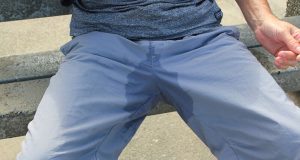By Allan Bucka Jones
Pride Health Columnist
Women, are any of these descriptions describing your situation?
You leak a few drops of urine while sneezing, laughing or coughing. You have a strong, sudden urge to urinate just before losing a large amount of urine (urinary incontinence). You leak stool (fecal incontinence).
If you answered yes to any of the three situations, you may need to do Kegel exercises.
Kegel exercises can help you prevent or control urinary incontinence and other pelvic floor problems. Kegel exercises strengthen the pelvic floor muscles, which support the uterus, bladder, small intestine and rectum. You can do Kegel exercises, also known as pelvic floor muscle training, discreetly just about any time.
Many factors, including pregnancy, childbirth, surgery, aging and being overweight, can weaken your pelvic floor muscles. Kegel exercises can be done during pregnancy or after childbirth to try to prevent urinary incontinence. Kegel exercises, along with counselling and sex therapy, might also be helpful for women who have persistent difficulty reaching orgasm.
Keep in mind that Kegel exercises are less helpful for women who have severe urine leakage when they sneeze, cough or laugh. Also, Kegel exercises are not helpful for women who unexpectedly leak small amounts of urine due to a full bladder (overflow incontinence).
It takes diligence to identify your pelvic floor muscles and learn how to contract and relax them. Here are some pointers:
Find the right muscles. To identify your pelvic floor muscles, stop urination in midstream. If you succeed, you’ve got the right muscles.
Perfect your technique. Once you have identified your pelvic floor muscles, empty your bladder and lie on your back. Tighten your pelvic floor muscles, hold the contraction for five seconds, and then relax for five seconds. Try it four or five times in a row. Work up to keeping the muscles contracted for 10 seconds at a time then relaxing for 10 seconds between contractions.
Maintain your focus. For best results, focus on tightening only your pelvic floor muscles. Be careful not to flex the muscles in your abdomen, thighs or buttocks. Avoid holding your breath. Instead, breathe freely during the exercises.
Repeat 3 times a day. Aim for at least three sets of 10 repetitions a day.
It is important that you do not make a habit of using Kegel exercises to start and stop your urine stream. Doing Kegel exercises while emptying your bladder can actually weaken the muscles, as well as lead to incomplete emptying of the bladder, which increases the risk of a urinary tract infection.
Make Kegel exercises part of your daily routine. You can do Kegel exercises discreetly just about any time, whether you are driving, sitting at your desk or relaxing on a couch. You might make a practice of fitting in a set every time you do a routine task, such as checking email.
If you are having trouble doing Kegel exercises, do not be embarrassed to ask for help. Your doctor or other health care provider can give you important feedback so that you learn to isolate and exercise the correct muscles.
If you do Kegel exercises regularly, you can expect results, such as less frequent urine leakage, within a few months. It has been reported that the exercises also lead to more enjoyable sex.
Ladies, for continued benefits, make Kegel exercises a permanent part of your daily routine.
Allan Bucka Jones is a Health Promoter and Broadcaster. He can be heard on “Allan Bucka Jones LIVE”, Sundays from 3 to 5pm on CHRY 105.5 FM, www.chry.fm option RDO.to , Rogers Digital Cable 945, Bell Fibe 973 or mobile app TuneIn Radio. You can contact Allan Bucka Jones at ajones@jjmedical.ca.
 Pride News Canada's Leader In African Canadian & Caribbean News, Views & Lifestyle
Pride News Canada's Leader In African Canadian & Caribbean News, Views & Lifestyle





